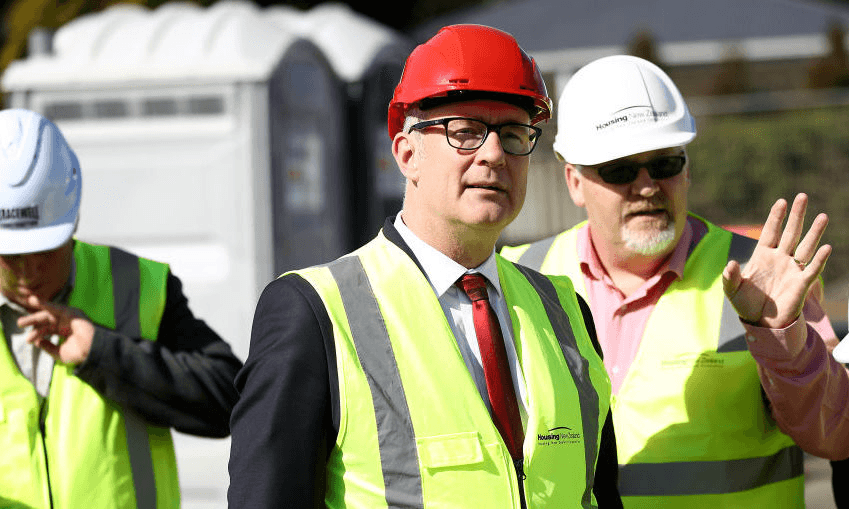Government fixation on gentrifying state housing neighbourhoods to provide sites for KiwiBuild developments seriously undermines the opportunity to meet the most pressing needs, writes Alan Johnson, the Child Poverty Action Group’s housing spokesperson.
The recent media preoccupation with KiwiBuild as a middle class welfare programme risks overlooking a far more critical housing story. It is not programmes like KiwiBuild that will get rough sleepers off the streets and allow families to move beyond sleeping in cars or garages, but more state housing.
After all, KiwiBuild is yet another variant of the trickle-down theme. In this instance the idea is that if we build enough $600K houses for young middle class households eventually the working poor and beneficiaries might be able to find a place to live. The last government’s housing minster Nick Smith pushed similar ideas when he suggested that if Auckland Council re-zoned enough greenfields land for suburbanisation, the market would be glutted with opportunity and eventually the working poor and beneficiaries might be able to find a place to live.
To be fair, both the current and former governments made commitments to build state housing. The National government, not too quick on the uptake, came to this realisation in late 2016 after public disquiet around homelessness grew too much to ignore. Most of the state house building activity we see in progress today has been put into place by the Bill English-led administration.
But it’s just not enough, and predictably so.
Figures released last week in the Ministry of Social Development’s Public Housing Quarterly Report illustrate well this shortfall. During the year to 30 September 2018 the priority waiting list for state housing grew by almost 3,700 households to just over 9,300. Over the same period the stock of social housing units – provided by Housing New Zealand or non-government providers – grew by 1,200 to slightly more than 67,400 dwellings.
It is true that the state housing waiting list under the National government was a political fabrication. MSD is the agency responsible for receiving and vetting applications for housing assistance. The complex application process it devised blocked or discouraged people from asking for help. Part of this process required people to ring up first for an initial assessment over the phone. Conveniently, the ministry didn’t bother to record how many people it turned away at this stage.
The current coalition government’s approach to offering housing assistance is more helpful and compassionate – and this is one of the reasons for the sudden jump in the waiting list numbers.
In November 2017 the Salvation Army published its estimates of future demand for state and social housing in a report titled Taking Stock. These estimates suggested that a minimum of 2,000 extra state and social housing units are required every year for the next 10 years.
There is nothing really scientific about this 2,000 per year figure – it was seen as about the number of additional retirees who will require social housing assistance each year. The numbers of working age people requiring such assistance was estimated to remain relatively stable. Two thousand was seen as both a minimum necessity and as financially doable.
But apparently it is not doable under the Labour-Greens pre-election budget responsibility pact. The 2018 Budget proposed to provide just 6,400 additional state and other social housing units over the following four years. This additional stock is mainly being funded off Housing New Zealand’s balance sheet in much the same way as the previous government operated.
Under present plans even this 6,400 new stock may be a big ask. Especially in Auckland where about half this 6,400 figure will be built – about 800 per year across the city.
Housing New Zealand’s Auckland Housing Plan is a well-considered and detailed programme which has been under way since late 2016 and due for completion in mid-2019. The plan is reported on HNZ’s website and involves mainly small scale suburban redevelopments on 127 sites across Auckland. The plan entails the demolition of around 550 old state houses and their replacement with 2,300 new townhouses, terrace houses and apartments. This is a net gain of 1,750 units over a three year period. Progress has been steady although it is not clear if the programme is still on track. If it is, and if planning and construction beyond 2019 are of a similar scale and success as this progress, it is just feasible that the target of 800 additional units per year in Auckland can be reached.
Grander plans for KiwiBuild threaten modest ambitions like these. In plans for the re-development of state housing neighbourhoods in Northcote, Mount Roskill and Mangere, Housing and Urban Development Minister Phil Twyford has announced the government’s intention to demolish more than 6,000 “worn out state houses” over the next 10 years and replace these with around 20,000 new dwellings at medium densities. Of these 20,000 new houses, approximately 6,500 will be state houses with the remainder divided between KiwiBuild and market priced housing. All this effort for just 500 more state houses over a decade?
Over the next 10 years Auckland probably requires 10,000 to 15,000 extra state and social housing units to cope with demand from both a growing and aging population. The government preoccupation with gentrifying state housing neighbourhoods in order to provide sites for its flagship KiwiBuild programme seriously undermines the opportunity to meet such needs.

